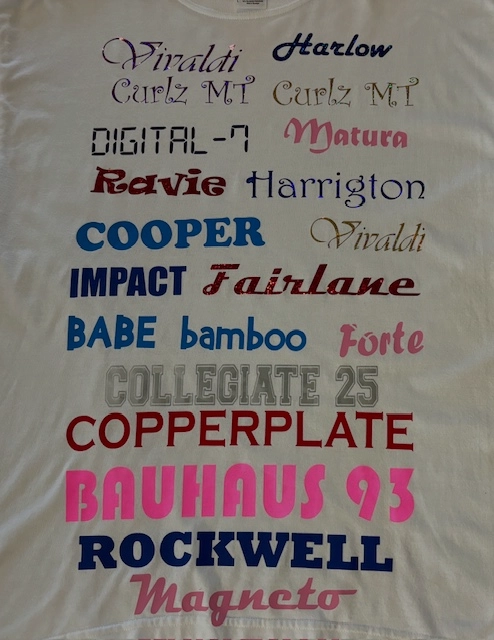The Art of Custom-made Embroidery: Opening the Keys to Creating Distinct and Unforgettable Styles
Embroidery, a craft soaked in practice and virtuosity, holds within its complex stitches the power to change fabric into a canvas of one-of-a-kind expression. The keys to developing custom-made needlework layouts that mesmerize the eye and leave a long-term impression depend on a fragile balance of strategy, creative thinking, and interest to information. As we delve right into the world of custom needlework, we reveal the nuanced interplay between thread option, stitch intricacy, and layout customization that raises a mere garment to a work of art. Join us on a trip with the art of customized needlework as we unravel the secrets behind crafting absolutely unforgettable and unique productions.
Selecting the Right Embroidery Threads
When picking needlework strings, what key elements should you consider to ensure the finest results for your customized designs? The choice of needlework thread is crucial in figuring out the last end result of your stitched style.
Moreover, the weight or density of the string plays a substantial duty in the appearance of the needlework. Thicker strings can include dimension and texture to your design, while finer threads are optimal for complex details and small text. In addition, considering the color fastness and washability of the string is vital to make certain that your personalized styles keep their quality and vibrancy gradually. By carefully assessing these variables and selecting premium threads that fulfill your details requirements, you can improve the visual appeal and durability of your embroidered developments.
Exploring Various Stitch Techniques
To look into the world of 'Discovering Various Stitch Strategies', one have to realize the intricacies and nuances that each sewing approach gives the art of needlework. Different stitch strategies not only add visual rate of interest but likewise add to the total texture and dimension of the layout. One prominent stitch method is the satin stitch, which entails closely packed parallel stitches to create a smooth and glossy surface, perfect for completing shapes and creating bold details.
On the other hand, the backstitch is a flexible method frequently made use of for detailing and including fine information. It involves sewing backwards to create a solid line of needlework. Additionally, the French knot stitch adds a tactile element to layouts, perfect for developing textured accents like flower facilities or ornamental touches.
Discovering various stitch methods allows embroiderers to play with light, shadow, and depth within their styles, elevating the aesthetic charm and imaginative quality of their embroidery projects. By grasping numerous stitching approaches, one can open endless possibilities for creating unique and unforgettable custom needlework pieces.
Incorporating Personalized Design Elements
Having actually explored the intricacies of different stitch methods such as the satin stitch, backstitch, and French knot, the emphasis now moves in the direction of incorporating customized style elements in personalized needlework jobs. Personalized style elements play a vital role in making embroidery tasks absolutely one-of-a-kind and remarkable. One method to include customization is by adding initials, names, or considerable days to the layout. This not only adds a customized touch however likewise improves the emotional value of the embroidery item.
Another method to include personalized design components is by including symbols or concepts that hold unique significance to the recipient or show their passions and character. Integrating a favorite flower, pet, or hobby-related symbol can make the embroidery style more meaningful and customized. Additionally, picking colors that resonate with the recipient or line up with the designated style can further boost the personalization of the embroidery project.
Understanding the Art of Shade Control
One key facet of shade sychronisation is understanding color concept. This includes understanding exactly how different shades connect with each other, the feelings they share, and how they can be integrated to develop visually attractive layouts. By applying color concept principles, embroiderers can create unified shade schemes that improve the overall appearance of the layout.
Additionally, paying attention to contrast is find more information crucial in look at more info shade coordination. Making use of contrasting colors can help certain components of the design pop, boost readability, and develop a visually dynamic needlework piece. By grasping the art of color sychronisation, embroiderers can boost their designs and create memorable pieces that resonate with clients and viewers alike.
Enhancing Structure With Advanced Embroidery Stitches

French knots, for instance, are perfect for including small, increased dots to your design, resembling the look of grains or creating a distinctive surface area. Bullion knots, on the other hand, can be made use of to develop twisted, ropelike elements that add an extravagant feeling to the needlework. Seed stitching entails small, scattered stitches that can complete areas with a multicolor texture, while turkey work creates fluffy, dimensional accents similar to animal custom made womens suits fur or foliage. Try out these sophisticated needlework stitches allows you to push the limits of traditional embroidery and produce genuinely one-of-a-kind and visually attractive textures in your styles.
Final Thought
To conclude, the art of custom needlework entails a mix of selecting the best strings, checking out numerous stitch strategies, integrating personalized design components, understanding shade sychronisation, and improving structure with sophisticated stitches. By recognizing and executing these crucial elements, embroiderers can produce special and unforgettable designs that showcase their imagination and ability. Embroidery fanatics can unlock the keys to producing lovely and custom pieces that stand out and leave a lasting impression.